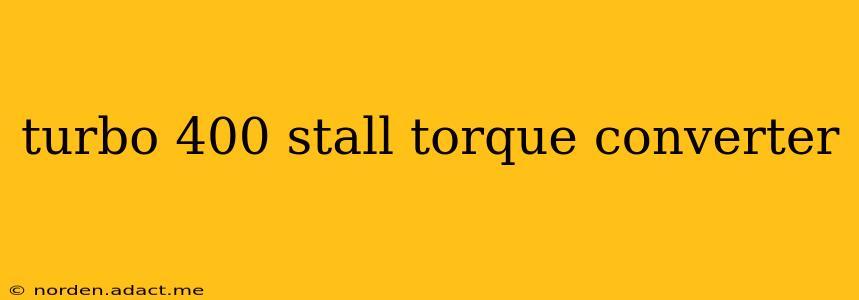The Turbo 400 transmission, a legendary powerhouse in the automotive world, is known for its durability and ability to handle significant horsepower. However, to unleash its full potential, choosing the right stall torque converter is crucial. This guide will delve into the intricacies of Turbo 400 stall converters, helping you understand how to select the perfect one for your application. We'll cover everything from understanding stall speed to matching converters to your vehicle's specifications and driving style.
What is a Stall Converter?
Before diving into the specifics of Turbo 400 stall converters, let's clarify what a stall converter actually does. A torque converter is the component that transmits power from your engine to the transmission. Unlike a direct clutch, it uses fluid to transfer power, allowing for smoother engagement and reduced shock. The "stall" speed refers to the engine's RPM at which the converter "locks up" – the point where the engine's speed no longer increases, even with the throttle fully depressed and the transmission in drive. A higher stall speed means the engine will rev higher before the transmission begins to engage, resulting in quicker acceleration and improved launch performance.
What are the Different Types of Turbo 400 Stall Converters?
Turbo 400 stall converters come in a wide range of stall speeds, each designed for different applications and driving styles. These variations generally fall into these categories:
-
Low Stall Converters (1500-2500 RPM): These converters offer improved fuel economy and smoother operation at lower speeds. They're suitable for street-driven vehicles that prioritize drivability over aggressive acceleration.
-
Medium Stall Converters (2500-3000 RPM): A good balance between performance and daily drivability. These offer a noticeable improvement in acceleration without being overly aggressive. They're a common choice for street/strip vehicles.
-
High Stall Converters (3000+ RPM): Designed for maximum acceleration and performance. These converters will significantly increase your engine's RPM before engaging the transmission, leading to a dramatic increase in launch speed. They are generally less suited for daily driving due to their aggressive nature and potential for overheating.
-
Custom Stall Converters: For those seeking the ultimate in performance, custom-built converters can be tailored to your specific engine, transmission, and driving style. These offer the most precise tuning and performance optimization.
How Do I Choose the Right Stall Speed for My Turbo 400?
Choosing the right stall speed depends on several factors:
-
Engine Power and Torque: A more powerful engine can handle a higher stall speed without sacrificing drivability.
-
Vehicle Weight: Heavier vehicles require higher stall speeds to achieve optimal acceleration.
-
Intended Use: Street-driven vehicles will typically benefit from lower stall speeds, while race cars may require significantly higher ones.
-
Tire Size and Gear Ratios: These factors significantly influence acceleration and should be considered when choosing a stall speed.
What are the Pros and Cons of High Stall Converters?
Pros of High Stall Converters:
- Increased Acceleration: Significantly faster launches and improved acceleration.
- Enhanced Performance: Optimal for drag racing and high-performance applications.
Cons of High Stall Converters:
- Reduced Fuel Economy: Higher stall speeds generally lead to reduced fuel efficiency.
- Rougher Idle: Can cause a rougher idle, especially at lower speeds.
- Potential for Overheating: Increased stress on the transmission and potential for overheating.
What about lockup converters?
Many modern Turbo 400 applications use a lockup torque converter. This feature allows the converter to "lock" at higher speeds, improving fuel efficiency and reducing heat generation. Consider if a lockup converter is essential for your build as it offers benefits for highway driving and better fuel economy.
What is the difference between a loose and a tight converter?
The terms "loose" and "tight" refer to the overall "feel" of the converter and are related to the stall speed and clutch engagement. A "loose" converter has a higher stall speed, and the transition to engagement feels more gradual, while a "tight" converter will have a lower stall speed and a quicker, more abrupt engagement. The best choice depends on your performance goals and driving style.
How much does a Turbo 400 stall converter cost?
The cost of a Turbo 400 stall converter varies depending on the brand, stall speed, and features. You can find converters ranging from a few hundred dollars to well over a thousand, depending on the complexity and specifications.
By carefully considering these factors and selecting the appropriate stall converter, you can unlock the full potential of your Turbo 400 transmission and enjoy a significant improvement in performance and driving experience. Remember to consult with a transmission specialist to ensure you choose the optimal converter for your specific needs.
